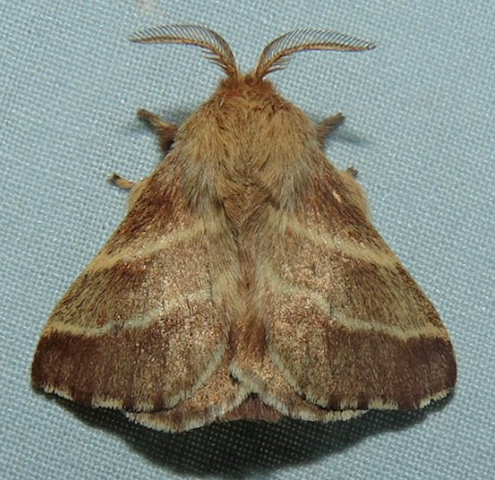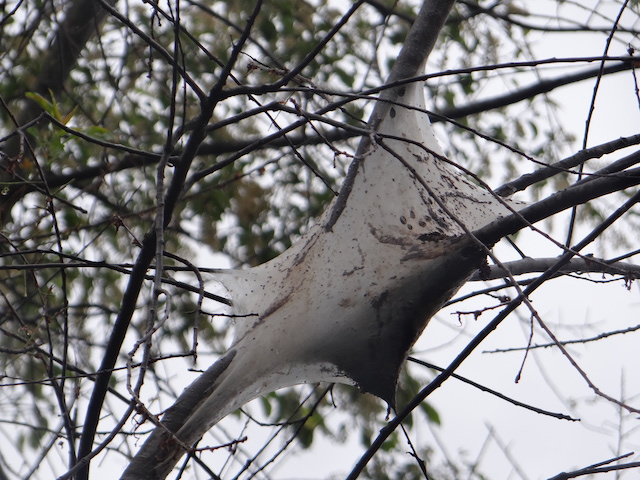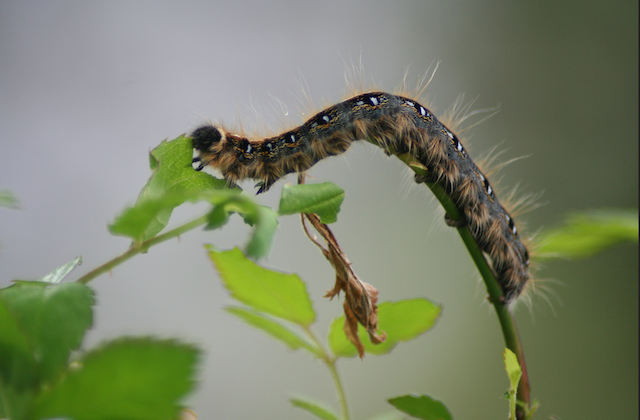There’s a wild black cherry tree on our back border that is just covered with webs and has been 80% defoliated by the Eastern Tent Caterpillars.
Do you get a feeling of revulsion when you see tent caterpillars in trees? Or when you recognize them crawling around on other plants and on walkways? I know *I* get kind of grossed out but we’re going to find out more about these pests.
The Eastern Tent Caterpillars (ETC) are among the most social of larvae. Think about most moths that lay eggs and the little caterpillars just do their own thing while on the same host plant. Not so the ETC. Mom, the plain looking brownish nocturnal moth, lays 200-400 eggs in a single batch sometime between late spring and early summer. All these eggs quickly develop micro caterpillars within the egg, but they just quietly wait a year until the tree buds are just developing and BAM! they all hatch.
As soon as they emerge in their hundreds, they all start spinning a silken webbing to hang out in, the more the merrier. Every time they are about to leave their tent, they add some more to it. In fact, this species builds the largest hideout of any sort of tent caterpillar. They orient their nests to catch the most sun and spin the thickest silk where the sun hits. They need sun to elevate their body temperatures so that they are able to digest their food. How do you know you are looking at an ETC nest without seeing the cats? They are in the crotches of the host trees and do not enclose leaves inside the webs–THAT is the sign of the Fall Webworm, active later.
Tent caterpillars emerge from their webbing three times a day, en masse to increasingly distant feeding sites, laying down pheromone trails behind them. Like the social ants, they mark the way for their brethren to come and get the food any explorers have found. After every feeding session, they hightail it back to the tent and hang out together, digesting, playing cards and telling bawdy caterpillar jokes, no doubt.
Another advantage of this large social gathering is the “group display”, like a school of fish makes a moving target. Predators or parasites are treated to the “twitch and writhe” display of a mass of hundreds thrashing around as a dissuasion.
Eventually, there is a signal to disperse and make an individual cocoon. And a couple weeks later, the moth emerges and the cycle begins anew.
ETC’s are said to have warning coloration–aposematism—“we’re hairy and we don’t taste good”. And those that eat cherry leaves are full of cyanogenic juices, which the cats regurgitate if they are disturbed.
Many sources remark that nothing will eat these except maybe a cuckoo. But, a scientific investigation by naturalists has revealed otherwise—that ETC are actually quite ecologically important and positive in the scheme of things.
Here is some information from Conservation Resource Alliance:
- The cats and moths are eaten or parasitized by at least 127 species–braconid, ichneumonid and chalcid wasps,for example.
- 60 bird species have been documented as eating them including orioles, jays, chickadees, nuthatches and cuckoos. In fact, during ETC season, it was found that birds feeding nestlings would turn down proffered mealworms in preference for ETC cats.
- A controlling action on the ETC population is provided by frogs, mice, bats, reptiles, squirrels, skunks, and bears. One researcher investigated bear poop and found evidence that a single bear averaged eating about 25,000 cats in a day. (retch!). Easy pickins’ during the ETC season! Just raid the nests.
So, from an environmentally conscious viewpoint, they are beneficial. But, what to do about the ones greedily feeding on your ornamental plum or crabapple trees?
- First, be thankful that it is only one generation yearly and it will gives the trees time to recover from the defoliation in a few weeks.
- In the fall and winter, the egg cases can be easily seen and picked off.
- During the tent phase, in the early morning or evening while the cats are still inside, take a stick and wind the tent mass around it or prune out the tents, then destroy them.
- Insecticides are said to be relatively ineffective against mature larvae, but young cats not in the webbing can be treated with bacillus thuringiensis varkurstaki in insecticidal spray.






